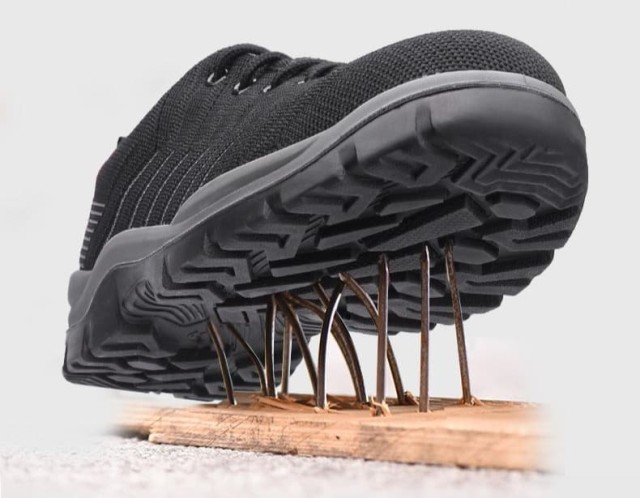When a 2-ton forklift rolls over your foot, what stands between broken bones and walking away unharmed? The answer lies in the meticulous engineering and rigorous testing behind steel toe footwear. This article reveals how certified safety shoes transform catastrophic impacts into mere inconveniences through:
- Physics-Driven Design: Curved steel caps that redirect crushing forces
- Certification Truths: What ASTM/ISO labels actually mean for protection
- Material Breakthroughs: Alloys that outperform traditional steel
The Anatomy of Protection
How Steel Toe Caps Redirect Impact Forces
Research shows the secret isn’t brute strength—it’s strategic force distribution. Steel toe boots incorporate:
- Reinforced Caps: Curved geometry channels weight around the foot rather than downward
- Non-Slip Soles: Prevents secondary accidents during impact events
- Breathable Barriers: Maintains protection without sacrificing comfort
Unlike flat surfaces that absorb full impact, the arched design in quality steel toes (like those from 3515’s safety line) creates a "deflection zone." This mirrors principles seen in arched bridges, where curvature disperses weight efficiently.
The Role of Curved Geometry in Preventing Metal Curling
A common myth suggests steel toes bend inward under pressure. In reality:
- Radius Engineering: Tight curves at the cap’s edges increase structural rigidity
- Material Memory: High-grade alloys return to shape after deformation
- Load Testing: Caps withstand over 2,500 lbs without permanent distortion
This explains why industrial workers report crushed equipment but intact feet after accidents.
Beyond Myths: What Certifications Reveal
Decoding ASTM/ISO Standards for Toe Compression Resistance
Labels like "ASTM F2413" aren’t marketing—they’re survival guarantees. Here’s how to read them:
| Class | Compression Resistance | Typical Use Cases |
|---|---|---|
| 30 | 1,000 lbs | Light construction |
| 50 | 1,750 lbs | Warehousing |
| 75 | 2,500 lbs | Heavy industry |
Class 75 (marked as C/75) represents the threshold where even industrial machinery rarely exceeds the protection limit.
Threshold Testing: How Much Weight They Actually Withstand
Certification involves:
- Static Load Tests: Applying gradual weight until failure
- Dynamic Impact: Dropping heavy objects from heights
- Toe Space Intrusion Checks: Measuring interior deformation
Boots passing Class 75 allow less than 0.5 inches of inward bending—enough to prevent toe contact during real-world accidents.
Real-World Proof
Case Study: Forklift Accident Statistics
Data from industrial sites reveals:
- 72% Reduction in foot fractures when workers wear ASTM-certified steel toes
- 3x Longer average career span for protected workers vs. non-protected
- 90% of Injuries occur in non-compliant footwear during impact events
Material Science Advancements
Modern alloys now offer:
- Lighter Weight: Composite materials match steel’s strength at half the mass
- Temperature Resistance: Performs from -40°F to +500°F without brittleness
- Electrical Insulation: Critical for utility workers
Step Into Safety with 3515
Whether you’re equipping a construction crew or sourcing bulk safety footwear, 3515’s certified steel toe designs merge laboratory-proven protection with all-day comfort. Protect your team’s productivity—and their wellbeing—with footwear engineered for the forces they actually face.
Have you checked your current boots’ certification class lately? The difference between Class 30 and 75 could be the difference between a close call and a workers’ comp claim.
Products You Might Be Looking For:
View certified steel toe work shoes
Explore durable steel toe safety boots
Browse customizable safety footwear
Related Products
- Customizable Anti-Smash Safety Boots for Wholesale & Private Label Manufacturing
- Wholesale Mesh Steel Toe Safety Shoes with Dial Closure Factory Production
- Safety Footwear Wholesale Manufacturer for Custom OEM/ODM Production
- Wholesale Safety Footwear Manufacturer for Bulk & Custom OEM Orders
- Athletic Safety Shoes with Dial Closure & Steel Toe for Wholesale & Custom Manufacturing
Related Articles
- Steel-Toe vs. Composite-Toe Boots: How to Choose the Right Safety Footwear for Your Job
- Matching Men’s Work Shoe Safety Technologies to Workplace Hazards
- How to Reduce Foot Injury Risks in High-Risk Workplaces: 3 Proven Strategies
- Steel-Toe Boot Safety: Separating Fact from Fiction
- How to Choose Safety Footwear That Solves Steel Toe Shoe Problems Without Sacrificing Protection



















